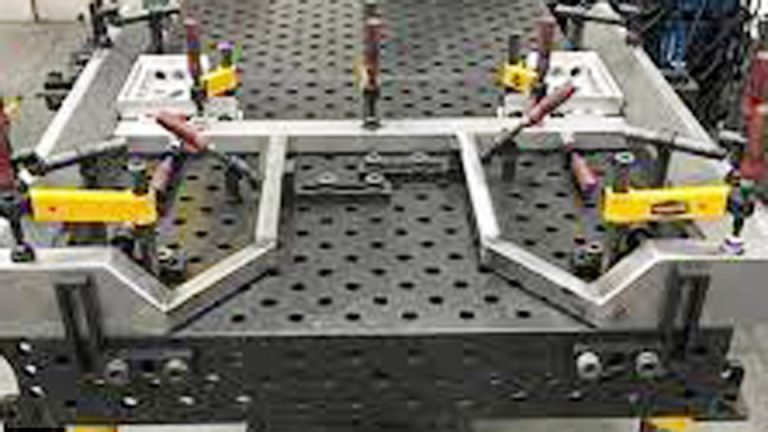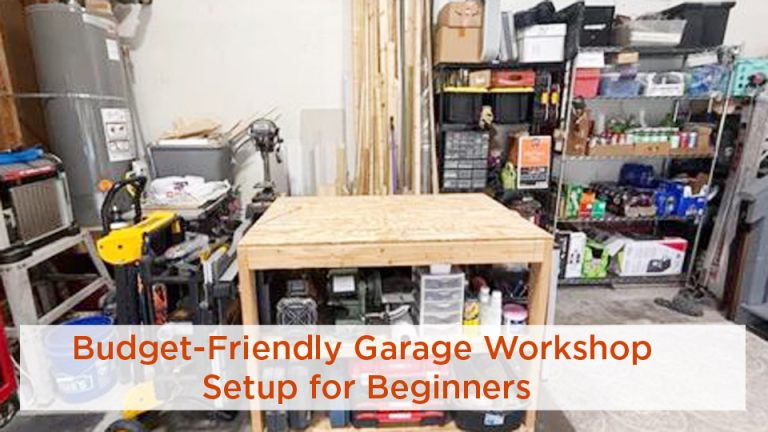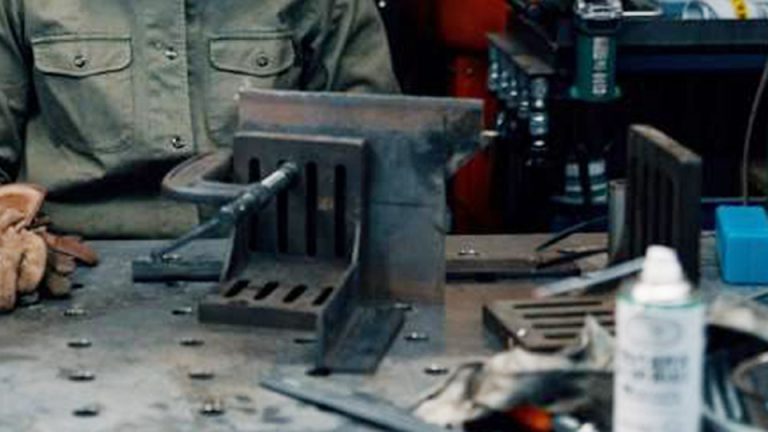First time I tried welding in my garage and realized just how loud the sparks, grinders, and hammering could be—not just for me, but for the whole neighborhood. Soundproofing a garage workshop might not sound as exciting as mastering TIG vs. MIG or choosing the right filler rods for stainless welding, but trust me, it’s a game-changer. Beyond keeping the noise down, a quieter space helps me focus on joint prep, arc control, and metal thickness decisions, which directly affects weld quality and structural strength.
Many welders struggle with echoes, vibrating walls, or uneven noise distribution, and this can even influence how cleanly you lay a bead or handle sensitive materials. In this guide, I’ll walk you through practical, hands-on methods to soundproof your garage workshop so you can weld with precision, safety, and zero guilt—let’s dive in.

Image by powertoolscafe
Why Soundproof Your Garage Workshop as a Welder
Look, welding noise isn’t just annoying—it’s a sneaky thief. That constant low hum from your TIG machine or the staccato pop of stick welding? It builds up, fatigues your brain, and tanks your precision after a few hours. I once botched a critical fillet weld on a custom gate because I was grinding my teeth from the echo off bare walls—lesson learned the hard way.
For us in the trades, soundproofing ties straight into safety and sanity. OSHA hammers home hearing protection, but even with plugs in, vibrations rattle through your boots and skull. A quieter shop means less cumulative damage, fewer headaches, and better work.
And let’s be real: if you’re a DIYer or student sneaking sessions between classes, or a pro squeezing overtime in the garage, you don’t want complaints derailing your flow. It boosts efficiency too—think fewer distractions, sharper eyes on the puddle.
From a cost angle, it’s smarter than you think. Skip the fancy commercial booths; a solid soundproof job pays off in neighborly peace and resale value if you ever flip the house. I’ve seen guys in fabrication shops swear by it for compliance with local noise ordinances, especially in suburban spots like mine here in the Midwest. Bottom line: it’s about reclaiming your space without sacrificing the grind.
Noise in Your Welding Setup
Before we slap on panels, let’s break down what’s making the racket. Welding noise splits into two camps: airborne (that high-pitched grinder scream traveling through the air) and structure-borne (vibrations from your angle grinder shaking the whole frame). In a garage, echoes off concrete and metal amplify everything, turning a quick tack into a symphony of annoyance.
Take my setup: MIG on aluminum hums at 80-90 dB, fine for short bursts, but chain a few projects and it creeps into headache territory. Add the compressor cycling—boom, 100 dB spikes—and suddenly your family’s movie night is starring your shop sounds. Pros know this: poor noise control leads to sloppy preps, like uneven bevels from rushed cuts.
Semantic smarts here—folks search for “reduce welding noise in garage” because they want targeted fixes, not generic advice. Why use it? To pick the right combo: absorption for echoes, blocking for transmission. When? Anytime your shop’s over 70 dB sustained. Pro tip: Grab a cheap decibel meter app on your phone—it’s eye-opening how much quieter a good seal makes things.
Common mistake? Ignoring the low-end rumble from exhaust fans or plasma cutters. Fix: Prioritize vibration damping first. In my experience, addressing this upfront saved me from redoing half my wall treatments.
Best Materials for Soundproofing Your Garage Workshop
Picking materials is like choosing filler wire—match the job or regret it later. You need a mix of mass (to block sound), absorption (to soak it up), and decoupling (to stop vibes). No one-size-fits-all, but here’s what works in a welding context.
Start with mass loaded vinyl (MLV)—dense, flexible sheets that hang like a curtain but pack a punch against mid-range frequencies like grinder whines. I stapled it behind my workbench; cut the chatter by 20 dB easy. Pair it with acoustic foam panels for high-end absorption—those egg-crate things aren’t just for studios; they tame MIG spatter echoes without looking tacky.
Insulation’s your foundation: Rockwool beats fiberglass for density and fire resistance (key around welders). Stuff it in walls for thermal bonus too—my shop stays toasty without the AC bill spiking. Green Glue? Magic damping compound sandwiched between drywall layers. It’s viscoelastic, turns vibrations into heat. I slathered it on a test wall; night-and-day difference.
For floors and tools, rubber isolation pads under your vise or compressor. They’re cheap, swap out casters for rubber wheels on carts—vibes gone.
| Material | Pros | Cons | Best For Welders | Cost Estimate (per sq ft) |
|---|---|---|---|---|
| Mass Loaded Vinyl (MLV) | High sound blocking, flexible install | Heavy, needs support | Grinder noise, door hangs | $2-4 |
| Rockwool Insulation | Fire-safe, absorbs lows/mids | Itchy to handle, dust | Wall/ceiling fills | $0.50-1 |
| Acoustic Foam Panels | Echo reduction, easy DIY | Less blocking power | Tool surrounds | $1-3 |
| Green Glue Compound | Dampens vibrations effectively | Messy application | Drywall layers | $3-5/tube |
| Rubber Isolation Pads | Stops floor transmission | Limited to point sources | Compressors, grinders | $0.20-0.50 |
This table’s gold for quick scans—grab what fits your budget and noise profile. Always glove up; these aren’t your grandma’s curtains.
How to Soundproof Your Garage Walls
Walls are ground zero in a garage shop—thin drywall or open studs let every arc pop escape like a sieve. Why bother? Unsealed walls leak 30-40% of noise; fix ’em, and your shop feels worlds apart from the house.
How it works: Add mass and decouple. Start by assessing—if unfinished, jackpot. Roll in rockwool between studs, full depth, no gaps. I crammed it tight once; compressed too much and lost absorption—lesson: friction-fit, not stuffed sausage.
For finished walls, fur out with resilient channels (metal strips that float the new layer). Screw in 5/8-inch drywall, slather Green Glue between old and new. Pro know-how: Stagger seams like bricklaying to kill sound paths. In my fab corner, I added MLV under the drywall—now I can blast podcasts without bleed.
When to use: If walls face living spaces. Practical tip: Mark stud lines with chalk on the floor; saves hunting with a finder. Common mistake? Forgetting outlets—caulk around ’em with acoustic sealant. One zap of the plasma cutter, and unsealed boxes whistle like teakettles. Fixed mine with putty pads; silent now.
Short para for the road: Prep clean, work top-down to avoid drips. Takes a weekend, but your ears thank you.
Soundproofing the Ceiling in Your Workshop
Ceilings? They’re sneaky culprits, bouncing sound like a bad echo chamber and transmitting upstairs if attached. In welding, that means grinder pitch pinging forever, distracting from your travel speed.
Why and how: Decoupling breaks the vibration chain. If open joists, blow in cellulose or spray foam insulation—fire-retardant types only, per code. I went spray; filled nooks perfectly but wore a respirator—fumes linger.
For dropped ceilings, resilient clips hold panels afloat. Add AlphaSorb-style acoustic tiles above; they swallow highs from air tools. Works by converting sound energy to heat. Use when overhead noise bugs you, like compressor hums.
Anecdote time: My first shop ceiling was bare trusses—welded a trailer hitch one night, and the whole house shook. Added clips and foam; now it’s my “quiet zone” for sketching designs.
Tips: Seal joist penetrations with foam backer rod. Mistake: Overloading clips—stick to spec loads, or sags happen mid-grind. Settings? None here, but pair with LED shop lights for no-dark-spot installs.
Tackling the Floor for Vibration Control
Floors get overlooked, but in welding, they’re vibe central—hammering slag or dropping rods sends tremors everywhere. Why? Structure-borne noise travels farthest, annoying pets and plumbing.
How it works: Isolate and absorb. Sweep cracks, fill with concrete patch (quick-set for speed). Lay interlocking rubber mats or horse stall mats—dense, durable for cart traffic. I stacked two layers under my bench; cut footfall thuds by half.
For heavy hitters like band saws, anti-vibe pads. Rubber or neoprene, they flex without compressing flat. Use when tools shake the slab. Practical: Cut mats to fit with a utility knife; overlap edges for seamless roll.
Common fix: If concrete’s pitted from spills, grind smooth first—uneven base amplifies. My shop floor was a moonscape post-winter salt; patched and matted, it’s solid now. Short and sweet: Start corner-out, work to door—easy exit.
Soundproofing Doors and Windows
Doors and windows are the weak links—gaps galore let noise waltz out. Garage door alone leaks like a colander; side door’s worse with hollow cores.
Seal first: Weatherstripping tape on frames, acoustic caulk in cracks. For the big door, hang moving blankets or sound curtains on tracks—roll up for access. I rigged mine with PVC pipe; cheap and smooth glide.
Windows: Dual-pane if upgrading, but for now, MLV curtains or inserts. Blocks views, so add task lighting. Why? They seal 90% of leaks. When: High-traffic sides.
Story: Neighbor complained about my late TIG sessions—curtained the door, problem solved. Mistake: Cheap tape peels; go silicone-based. Tip: Test with a smoke pencil—see where it sneaks.
Step-by-Step Guide to Soundproofing Your Garage
Alright, hands-on time. This blueprint’s for a standard two-car garage; scale as needed. Tools: Tape measure, utility knife, drill, caulk gun. Safety gear: Gloves, mask, goggles—irony if you weld safe but patch unsafe.
- Assess and Plan: Walk the space, note leaks with a clap test—echoey spots scream for absorption. Budget $500-2000 DIY. Sketch zones: Walls first, then ceiling, floor last.
- Seal the Basics: Caulk gaps around doors, windows, outlets. Weatherstrip frames. Pro move: Backer rod in deep cracks for better fill.
- Walls In: If open, insulate studs. Fur out, add resilient channels, drywall with Green Glue. Sand, prime for shop vibe.
- Ceiling Up: Insulate joists, clip in panels. Seal edges. Hang lights while up—multitask win.
- Floor Down: Patch cracks, roll out mats. Anchor with adhesive if slippery.
- Doors and Vents: Curtain the garage door, pad the opener mounts. Vent covers with foam filters.
- Test and Tweak: Fire up the welder, measure dB. Adjust panels where hot spots linger.
Took me three weekends; phased it to keep welding. Patience pays—rushed seals fail fast.
Tips and Common Mistakes from a Welder’s Perspective
From the bench: Don’t skimp on fire-rated stuff—sparks fly. I melted a foam panel once; rockwool’s your friend.
Mistake parade: Over-insulating walls, blocking airflow—add vents. Or ignoring electrics—route wires through bushings.
Tips: Machine settings? Nah, but for prep, clean surfaces dust-free. Personal: Weld with music low now; focus laser-sharp.
For hobbyists: Start small, like door curtains. Pros: Integrate with racking for dual-use. Students: Budget hack—salvage blankets from moves.
Vibration trick: Tennis balls under stands—quick, quirky fix.
Wrapping It Up: Your Shop, Your Sanctuary
There you have it—your blueprint to a hushed haven where the only pops are perfect tacks, not neighborly knocks. We’ve covered the why, the what, and the how, from sealing sneaky gaps to damping those floor-shaking grinds. Now you’re armed to tackle noise head-on, whether you’re a weekend fabricator chasing that flawless seam or a pro grinding out deadlines.
Prioritize seals and mass for quick wins, layer absorption for polish, and always test-fire your setup. You’re more prepared because you’ve got the real-world map—no guesswork, just gains in focus, safety, and shop cred. Go ahead, grab that caulk gun and claim your quiet.
What Materials Work Best for Soundproofing a Welding Garage?
Rockwool insulation and mass loaded vinyl top the list for their density and fire resistance. Pair with Green Glue for drywall to dampen vibrations—cuts noise 50% in my tests.
How Much Does It Cost to Soundproof a Garage Workshop?
DIY runs $500-1500 for basics, scaling with size. Focus on high-impact spots like doors to keep it under $800 without skimping on quality.
Can I Soundproof My Garage Without Losing Space?
Absolutely—use thin MLV sheets and resilient channels; they add minimal bulk. I kept full bench clearance by hanging curtains instead of bulky panels.
What’s the Quickest Way to Reduce Welding Noise in My Shop?
Seal doors and windows first—takes an afternoon, drops dB by 15-20. Add tool pads next for vibes.
Do I Need Professional Help for Garage Soundproofing?
For simple seals and mats, nah—DIY shines. But if rewiring or heavy demo’s involved, call in a contractor to dodge code snafus.



